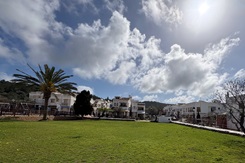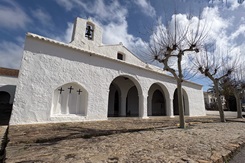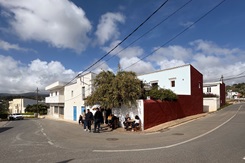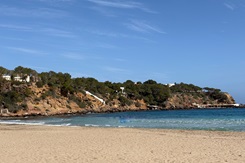San Carlos de Peralta (Sant Carles de Peralta) is a picturesque village in the eastern part of Ibiza, known for its rich history, beautiful natural landscapes, and peaceful atmosphere. Famous for its 18th-century church, the renowned hippie markets of Las Dalias and Punta Arabí, and its proximity to some of the island’s most popular beaches, San Carlos offers a perfect blend of culture and nature. In addition, visitors can enjoy local gastronomy with fresh products from the sea and land, and explore various hiking and cycling routes in the surrounding area. This destination, which preserves the traditional essence of Ibiza, is ideal for those looking to escape mass tourism and experience the most authentic side of Ibiza.
Ibiza, known for its vibrant nightlife and natural beauty, is also home to charming villages that have preserved their rural traditions. One of these villages is Sant Carles de Peralta (San Carlos), located in the eastern part of the island, in the municipality of Santa Eulària des Riu. This picturesque corner of Ibiza, with its rich history, lush nature, and peaceful essence, is an ideal place for those seeking to disconnect as well as for those wishing to explore the authentic Ibizan spirit.
A Village of Sea and Land
The character of San Carlos de Peralta has been shaped by the influence of two essential elements: the sea and the land. The area that makes up this parish is generous in Mediterranean landscapes that offer both a coastal and rural environment, with beautiful valleys, cliffs, and coves. This fusion of sea and land not only defines the geography of the place but also the daily life of its inhabitants, marked by the agricultural and fishing traditions of its people. Fields of crops blend with the sea breeze, creating an ideal atmosphere for those seeking peace in nature and the authenticity of the island.

The Church of San Carlos: A Monument of History and Architecture
One of the main attractions of San Carlos de Peralta is its church, the Church of San Carlos, which dates back to the late 18th century. This religious building is an excellent example of Ibizan architecture from the last third of that century. The church was severely damaged during the Spanish Civil War (1936-1939), losing a large portion of its movable heritage, but it was carefully rebuilt after the conflict.
The church has a rectangular floor plan, with a wide, single nave, a “Fonda” or Roser chapel, and an upper choir. It is characterized by having seven small side openings that act as chapels, as well as several attached constructions that give it a defensive and highly volumetric appearance, accentuated by the white color of its walls. Among the attached structures are the rectory and a cultural center, which further enrich the architectural ensemble.
The most prominent feature of the church is its porch (porxo), which is wide and long. This porch is accessible through three semicircular arches supported by pillars. Inside, the arcades are repeated in a double row, with exposed wooden beams, which gives the space a particular warmth and charm. Additionally, it preserves a small well located inside, adding a touch of antiquity and authenticity to this religious space.
On the exterior of the church, the roof of the Roser chapel is visible, and the angled belfry rises as a distinctive architectural element. Its imposing presence and unique architecture make it a landmark of the island’s religious heritage and a must-see for visitors to the village.

A Heritage Treasure
But San Carlos is not only known for its church. In the vicinity, visitors can discover other ethnographic treasures that bear witness to the island’s history. One of them is the Font de Peralta, a stone fountain dating back to the 17th century, located in a beautiful natural setting. It is also possible to visit the Trull de Ca n'Andreu Museum, a traditional rural house that houses an 18th-century oil mill and other elements representing ancient Ibizan architecture.
Additionally, as is common in several coastal areas of the island, San Carlos de Peralta is home to a defense tower, the Torre d’en Valls, built in the 18th century to protect the island from potential invasions. From this location, visitors can enjoy a spectacular panoramic view of the island of Tagomago, an iconic symbol of the municipality's coastline, which is designated as a Special Protection Area for Birds (ZEPA).
The Markets and the Hippie Legacy
San Carlos de Peralta is also a place deeply marked by the history of the hippie counterculture. From the 1960s onward, the town and its surroundings began to receive an influx of hippies seeking freedom and creativity. This influence is still alive in the town's atmosphere, particularly in its famous markets, such as the Las Dalias market and the Punta Arabí market. Both markets reflect the bohemian spirit of Ibiza, offering handmade products, alternative clothing, jewelry, and local food, keeping the essence of those years alive.
Local Gastronomy
One of the aspects that best reflects the relationship of San Carlos de Peralta with its land and sea is its gastronomy. The local restaurants offer a wide variety of traditional dishes made with local products, many of which come directly from the coast or nearby farms. Ibizan lamb (anyell d’Eivissa) is one of the most characteristic dishes you can taste in the village's restaurants, a delicacy that highlights the island's livestock tradition.
An emblematic place that reflects the essence of both the gastronomy and history of San Carlos is the Bar Anita restaurant, known to the locals as Ca n’Anneta. This bar, located in the heart of the village next to the church, is one of the oldest on the island, giving it a unique charm. Founded in the 1960s by a woman named Anita, who bought the small village shop and turned it into what is today this famous establishment, Bar Anita quickly became an essential meeting point for locals and tourists, especially during the cultural revolution on the island, driven by the hippies of that time.

Beaches and Nature: A Destination for Nature Lovers
San Carlos de Peralta is not only a place of cultural and historical interest but also a perfect destination to enjoy nature and the sea. Around the village, you will find some of the most beautiful and peaceful beaches on the island, such as Cala Mastella, Cala Llenya, Cala Nova, and Es Canar, the latter known for its family-friendly and relaxed atmosphere. Additionally, San Carlos is on the route to other stunning beaches like Cala Boix, Es Figueral, and Aigües Blanques, all famous for their natural beauty.
If you enjoy hiking or cycling, the routes in the area will also allow you to experience the Mediterranean landscape in an active way. Cycling routes No. 1, No. 2, No. 3, and No. 5, as well as hiking routes No. 1, No. 7, and No. 11, offer tours through some of the most beautiful and peaceful areas of Ibiza. This is a healthy and sustainable way to explore the island, especially in the spring and fall when the weather is milder and nature is at its peak.

Conclusion
San Carlos de Peralta is a place that invites you to disconnect and enjoy the most authentic Ibiza. Its rich history, incomparable natural surroundings, and vibrant cultural heritage make it an ideal destination for those seeking tranquility and for those who wish to explore the island’s history and traditions. If you are interested in rural life, traditional gastronomy, the Mediterranean Sea, and the charm of a village full of history, San Carlos de Peralta is undoubtedly a place you should visit.
Source:
- Ayuntamiento de Santa Eulària des Riu
- Visitsantaeulalia
- Illesbalears.travel